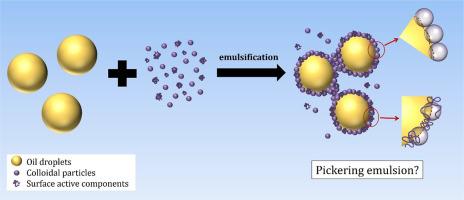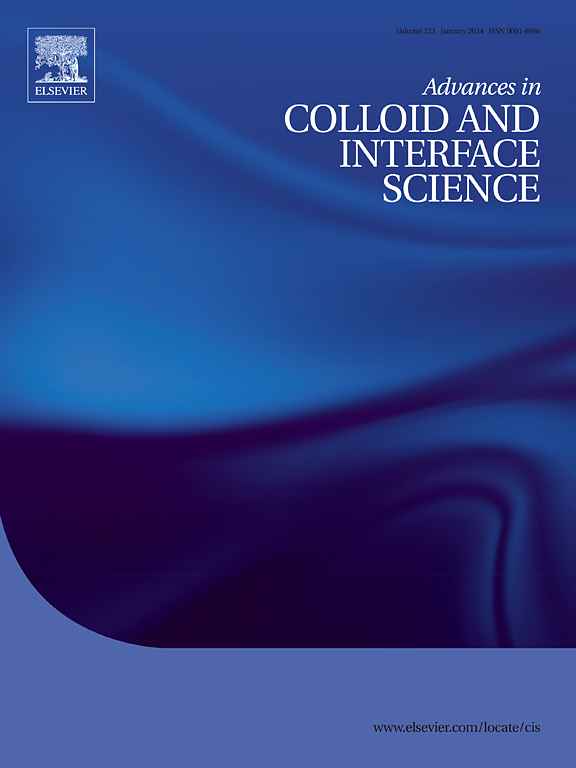From theoretical aspects to practical food Pickering emulsions: Formation, stabilization, and complexities linked to the use of colloidal food particles
IF 15.9
1区 化学
Q1 CHEMISTRY, PHYSICAL
引用次数: 0
Abstract
We noticed that in literature, the term Pickering emulsion (PE) is used as soon as ingredients contain particles, and in this review, we ask ourselves if that is done rightfully so. The basic behavior taking place in particle-stabilized emulsions leads to the conclusion that the desorption energy of particles is generally high making particles highly suited to physically stabilize emulsions. Exceptions are particles with extreme contact angles or systems with very low interfacial tension.
Particles used in food and biobased applications are soft, can deform when adsorbed, and most probably have molecules extending into both phases thus increasing desorption energy. Besides, surface-active components will be present either in the ingredients or generated by the emulsification process used, which will reduce the energy of desorption, either by reduced interfacial tension, or changes in the contact angle. In this paper, we describe the relative relevance of these aspects, and how to distinguish them in practice.
Practical food emulsions may derive part of their stability from the presence of particles, but most likely have mixed interfaces, and are thus not PEs. Especially when small particles are used to stabilize (sub)micrometer droplets, emulsions may become unstable upon receiving a heat treatment. Stability can be enhanced by connecting the particles or creating network that spans the product, albeit this goes beyond classical Pickering stabilization. Through the architecture of PEs, special functionalities can be created, such as reduction of lipid oxidation, and controlled release features.

从理论到实用的食品皮克林乳剂:胶体食品颗粒的形成、稳定以及与之相关的复杂性
我们注意到,在文献中,只要成分中含有微粒,就会使用皮克林乳液(PE)这一术语。从颗粒稳定乳液的基本行为可以得出结论:颗粒的解吸能通常很高,因此颗粒非常适合物理稳定乳液。食品和生物基应用中使用的颗粒很软,吸附时会变形,而且很可能有分子延伸到两相,从而增加了解吸能。此外,配料中或乳化过程中会产生表面活性成分,这些成分会通过降低界面张力或改变接触角来降低解吸能。在本文中,我们将介绍这些方面的相对相关性,以及如何在实践中区分它们。实用食品乳剂的部分稳定性可能来自颗粒的存在,但很可能具有混合界面,因此不是 PE。特别是当使用小颗粒来稳定(亚)微米液滴时,乳剂在接受热处理后可能会变得不稳定。尽管这已超出了传统的皮克林稳定法,但可通过连接颗粒或创建横跨产品的网络来增强稳定性。通过聚乙烯的结构,可以创造出特殊的功能,如减少脂质氧化和控制释放功能。
本文章由计算机程序翻译,如有差异,请以英文原文为准。
求助全文
约1分钟内获得全文
求助全文
来源期刊
CiteScore
28.50
自引率
2.60%
发文量
175
审稿时长
31 days
期刊介绍:
"Advances in Colloid and Interface Science" is an international journal that focuses on experimental and theoretical developments in interfacial and colloidal phenomena. The journal covers a wide range of disciplines including biology, chemistry, physics, and technology.
The journal accepts review articles on any topic within the scope of colloid and interface science. These articles should provide an in-depth analysis of the subject matter, offering a critical review of the current state of the field. The author's informed opinion on the topic should also be included. The manuscript should compare and contrast ideas found in the reviewed literature and address the limitations of these ideas.
Typically, the articles published in this journal are written by recognized experts in the field.

 求助内容:
求助内容: 应助结果提醒方式:
应助结果提醒方式:


